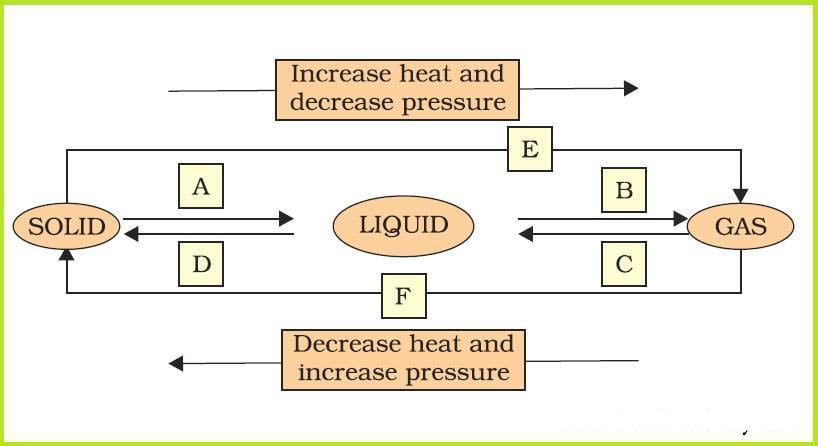NCERT Solution Class 9th Science Chapter 1: Matter in our Surroundings, NCERT Solution Class 9th Science Chapter 1, You find complete Chapter Details Question and Answer. All Question and Answer Explain the expert teacher and as per the NCERT (CBSE) guidelines.
NCERT
Solution Class
9thScience Chapter 1:
Matter in our Surroundings
- NCERTSolution Class9thScience Chapter 1:Matter in our Surroundings
- Exercises
- 3: Give reasons for the following observations.
- 4: Arrange the following in increasing order of forces of attraction between the particles
- – water, sugar, oxygen.Answer: Oxygen < Water < Sugar.
- 5: What is the physical state of water at —
- 6: Give two reasons to justify:
- 7: Why is ice at 273 K more effective in cooling than water at the same temperature?
- 8: What produces more severe burns, boiling water or steam?
- 9: Name A, B, C, D, E and F in the following diagram showing a change in its state:
- Class 9th Solution Science Chapter 1: Matter in our Surroundings.
- Question
- 1: Which of the following are matters?
- 2: Give reasons for the following observation:
- 3: A diver is able to cut through water in a swimming pool. Which property of matter does this observation show?
- 4: What are the characteristics of particles of matter?
- 1: The mass per unit volume of a substance is called density
- 2: a) Tabulate the differences in the characteristics of states of matter.
- Answer: The differences in the characteristics of states of matter are given in the following table.
- 3: Give reasons:
- 4: Liquids generally have lower density as compared to solids.
- Class 9th Science – Objective Type Question-answer
- 1: Why does a desert cooler cool better on a hot dry day?
- 2: How does water keep in an earthen pot (matka) become cool during summers?
- 3: Why does our palm feel cold when we put some acetone or petrol or perfume on it?
- 4: Why are we able to sip hot tea or milk faster from a saucer than a cup?
- 5: What type of clothes should we wear in summers?
- Question
Exercises
1: Convert the following temperatures into the Celsius scale.
(a) 300 K (b) 573 K
Answer:
(a) 300 K = 300 – 273 = 27 0C
(b) 573 K = 573 – 273 = 300 0C
2: Convert the following temperatures into the Kelvin scale.
(a) 25OC (b) 373OC
Answer :
(a) 25OC = 25 + 273 = 298 K
(b) 373OC = 373 + 273 = 646 K
3: Give reasons for the following observations.
(a) Naphthalene balls disappear with time without leaving any solid.
Answer: Naphthalene shows the property of sublimation. Evaporation of naphthalene takes place easily and so it disappears during the course of time without leaving a solid.
(b) We can get the smell of perfume sitting several meters away.
Answer: Perfumes vaporize very fast and its vapors diffuse into the air easily. That is why we can smell perfume sitting several meters away
4: Arrange the following in increasing order of forces of attraction between the particles
– water, sugar, oxygen.
Answer: Oxygen < Water < Sugar.
5: What is the physical state of water at —
(a) 25°C (b) 0°C (c) 100°C?
Answer:
(a) Liquid
(b) Solid and Liquid
(c) Liquid and Vapours
6: Give two reasons to justify:
(a) Water at room temperature is a liquid.
Answer: Water at room temperature is a liquid because it has fluidity and has a definite volume but no definite shape.
(b) An iron almirah is a solid at room temperature.
Answer: An iron almirah is a solid at room temperature because it is rigid and has a definite shape.
7: Why is ice at 273 K more effective in cooling than water at the same temperature?
Answer: Ice at 273 K is less energetic than water. It is because of the difference in the latent heat of fusion which is present in water at the same temperature in the form of extra energy.
8: What produces more severe burns, boiling water or steam?
Answer: Steam produces more severe burns than boiling water. This is because steam has more energy than boiling water, present in it in the form of latent heat of vaporization.
9: Name A, B, C, D, E and F in the following diagram showing a change in its state:

Answer:
A → Melting
B → Boiling
C → Condensation
D → Solidification
E → Sublimation
F → Sublimation
Class 9th Solution Science Chapter 1: Matter in our Surroundings.
Question
1: Which of the following are matters?
Chair, air, love, smell, hate, almonds, thought, cold, cold drink, the smell of perfume.
Answer:
- Anything that occupies space and has mass is called matter. Matter can exist in three physical states—solid, liquid, and gaseous.
- Chair and almond are forms of matter in the solid-state.
- A cold drink is a liquid state of matter.
- Air and smell of perfume are gaseous states of matter.
Note: The sense of smell does not matter. However, the smell or odor of a substance is classified as matter. The smell of any substance (say, perfume) is the gaseous form of that substance which our olfactory system can detect (even at very low concentrations). Hence, the smell of perfume is matters.
2: Give reasons for the following observation:
The smell of hot sizzling food reaches you several meters away, but to get the smell from cold food you have to go close.
Answer: Solids diffuse at a very slow rate. But, if the temperature of the solid is increased, then the rate of diffusion of the solid particles into air increases. This is due to an increase in the kinetic energy of solid particles. Hence, the smell of hot sizzling food reaches us even at a distance, but to get the smell from cold food we have to go close.
3: A diver is able to cut through water in a swimming pool. Which property of matter does this observation show?
Answer: The ability of a diver to cut through water in a swimming pool shows that matter is made up of particles.
4: What are the characteristics of particles of matter?
Answer:
- The characteristics of particles of matter are:
- Particles of matter have spaces between them.
- Particles of matter are continuously moving.
- Particles of matter attract each other.
NCERT Solution Class 9th Science Chapter 1: Matter in our Surroundings.
See Also: NCERT Solutions for Class 9 Science
1: The mass per unit volume of a substance is called density
(density = mass/volume). Arrange the following in order of increasing density − air, exhaust from the chimney, honey, water, chalk, cotton, and iron.
Answer: The given substances in the increasing order of their densities can be represented as Air < Exhaust from chimney < Cotton < Water < Honey < Chalk < Iron.
2: a) Tabulate the differences in the characteristics of states of matter.
Answer: The differences in the characteristics of states of matter are given in the following table.

b) Comment upon the following: rigidity, compressibility, fluidity, filling a gas container, shape, kinetic energy, and density.
Answer:
- The rigidity can be expressed as the tendency of matter to resist a change in shape.
- Compressibility is the ability to be reduced to a lower volume when force is applied.
- Fluidity is the ability to flow.
- By filling a gas container we mean the attainment of the shape of the container by gas.
- The shape defines a definite boundary.
- Kinetic energy is the energy possessed by a particle due to its motion.
- Density is mass per unit volume.
3: Give reasons:
a) A gas fills completely the vessel in which it is kept.
Answer: There is little attraction between particles of gas. Thus, gas particles move freely in all directions. Therefore, gas completely fills the vessel in which it is kept.
b) A gas exerts pressure on the walls of the container.
Answer: Particles of gas move randomly in all directions at high speed. As a result, the particles hit each other and also hit the walls of the container with a force. Therefore, gas exerts pressure on the walls of the container.
c) A wooden table should be called a solid.
Answer: A wooden table has a definite shape and volume. It is very rigid and cannot be compressed i.e., it has the characteristics of a solid. Hence, a wooden table should be called a solid.
d) We can easily move our hands in the air, but to do the same through a solid block of wood, we need a karate expert.
Answer: Particles of the air have large spaces between them. On the other hand, wood has little space between its particles. Also, it is rigid. For this reason, we can easily move our hands in the air, but to do the same through a solid block of wood, we need a karate expert.
4: Liquids generally have lower density as compared to solids.
But you must have observed that ice floats on water. Find out why.
Answer:
- The mass per unit volume of a substance is called density (density = mass/volume).
- As the volume of a substance increases, its density decreases.
- Though ice is solid, it has a large number of empty spaces between its particles.
- These spaces are larger as compared to the spaces present between the particles of water.
- Thus, the volume of ice is greater than that of water.
- Hence, the density of ice is less than that of water.
- A substance with a lower density than water can float on water.
- Therefore, ice floats on water.
Class 9th Science – Objective Type Question-answer
See Also: NCERT Solutions for Class 9th: Ch 1 Matter in Our Surroundings
1: Convert the following temperature to Celsius scale:
a) 300 K
b) 573 K
Answer:
a) 300 K = (300 − 273)°C = 27°C
b) 573 K = (573 − 273)°C = 300°C
2: What is the physical state of water at:
a) 250°C
b) 100°C
Answer:
a) Water at 250°C exists in a gaseous state.
b) At 100°C, water can exist in both liquid and gaseous forms. At this temperature, after getting the heat equal to the latent heat of vaporization, water starts changing from liquid state to gaseous state.
3: For any substance, why does the temperature remain constant during the change of state?
Answer: During a change of state, the temperature remains constant. This is because all the heat supplied to increase the temperature is utilized (as latent heat) in changing the state by overcoming the forces of attraction between the particles. Therefore, this heat does not contribute to increasing the temperature of the substance.
4: Suggest a method to liquefy atmospheric gases.
Answer: By applying pressure and reducing the temperature, atmospheric gases can be liquefied.
NCERT Solution Class 9th Science Chapter 1
[table id=1 /]
1: Why does a desert cooler cool better on a hot dry day?
Answer: When a liquid evaporates, the particles of the liquid absorb energy from the surroundings to compensate for the loss of energy during evaporation. This makes the surroundings cool.
In a desert cooler, the water inside it is made to evaporate. This leads to the absorption of energy from the surroundings, thereby cooling the surroundings. Again, we know that evaporation depends on the amount of water vapor present in the air (humidity).
If the amount of water vapor present in the air is less, then evaporation is more. On a hot dry day, the amount of water vapor present in the air is less. Thus, water present inside the desert cooler evaporates more, thereby cooling the surroundings more. That is why a desert cooler cools better on a hot dry day.
2: How does water keep in an earthen pot (matka) become cool during summers?
Answer: When a liquid evaporates, the particles of the liquid absorb energy from the container to compensate for the loss of energy during evaporation. This makes the remaining water cool.
There are some pores in an earthen pot through which the liquid inside the pot evaporates. This evaporation makes the water inside the pot cool. In this way, water kept in an earthen pot becomes cool during summers.
3: Why does our palm feel cold when we put some acetone or petrol or perfume on it?
Answer: When we put some acetone or petrol or perfume on our palm, it evaporates. During evaporation, particles of the liquid absorb energy from the surrounding or the surface of the palm to compensate for the loss of energy, making the surroundings cool. Hence, our palm feels cold when we put some acetone or petrol or perfume on it.
4: Why are we able to sip hot tea or milk faster from a saucer than a cup?
Answer: A liquid has a larger surface area in a saucer than in a cup. Thus, it evaporates faster and cools faster in a saucer than in a cup. For this reason, we are able to sip hot tea or milk faster from a saucer than a cup.
5: What type of clothes should we wear in summers?
Answer: We should wear cotton clothes in summers. During summers, we sweat more. On the other hand, cotton is a good absorber of water. Thus, it absorbs sweat from our body and exposes the liquid to the atmosphere, making evaporation faster.
During this evaporation, particles on the surface of the liquid gain energy from our body surface, making the body cool.

Hi, I’m Dev Kirtonia, Founder & CEO of Dev Library. A website that provides all SCERT, NCERT 3 to 12, and BA, B.com, B.Sc, and Computer Science with Post Graduate Notes & Suggestions, Novel, eBooks, Biography, Quotes, Study Materials, and more.






